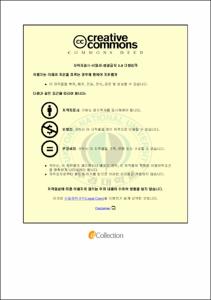정보디자인 모델을 통해 나타나는 User의 문화적 차이에 대한 연구
- Abstract
- A Study on Cultural Differences in Internet Users through Information Design Model
- Emphasis on Internet User's Behaviors -
Sung Man Kim
Department of Industrial Design, The Graduate School
Pukyong National University
Abstract
This research focuses on the behaviors of informational users through contrary concepts of cultural diversity and universality, and thereby formulating informational design model to elucidate glocalization. Also, another purpose of the research is to formulate an aspect of conceptual foundation in informational design approaches through cultural differences found in informational users’ behaviors.
The research can be summarized as follows.
In Chapter 2, the paper explores behavioral information theory by studying informational users’ behavior
Chapter 3, the paper presents theoretical basis for cultural research model after exploring cultural structure, model and variances.
In Chapter 4, the paper introduces theoretical bases of processing informational designs and concepts as well as through Chapter 3’s cultural theory.
In Chapter 5, the paper focuses on verification of research model from Chapter 4 by analyzing internet users’ behaviors via Digital Cultural Index (DCI).
Results from Chapter 5’s analysis can be summarize as follows
Implications of utilization of DCI in analysis of informational design model for cultural differences in internet users can be list as such.
First, DCI provides means of quantitative measurement and assessment for informational users’ cultural differences in which academic deliberation is insufficiently studied secondary to dynamic digital design environment.
Also, compare to previous informational design studies which focused on informational shape, DCI allows integrations of internet users’ behaviors for sharing and participating in online as well as psychological aspects including ethical, and aesthetics in informational design.
As such, DCI guides and induces outlining more balanced and sensitive approach to digital design which is superior in comprehensiveness.
Further research is needed in future since DCI analytical method is not the gold standard, and is not comprehensive. DCI has its limitations in practical applications and methods.
Therefore, DCI and its interpretation obtained from informational users should be understood in relative concepts rather than absolute.
Finally, constant development of new DCI and updates in applications of information design are necessary to restructure previous digital cultural data and to add any changes that occur in future.
- Issued Date
- 2010
- Awarded Date
- 2010. 2
- Type
- Dissertation
- Keyword
- 정보디자인
- Publisher
- 부경대학교
- Affiliation
- 부경대학교 대학원
- Department
- 대학원 산업디자인학과
- Advisor
- 김선화
- Table Of Contents
- 목 차
Ⅰ. 서 론
1. 연구배경 및 목적 1
2. 연구방법 및 범위 2
Ⅱ. 사용자(User) 행동의 고찰
2-1. 사용자 행동의 개념과 모델 5
2-1-1. 사용자 행동의 개념과 분류 5
2-1-2. 사용자 행동의 모델 9
2-2. 사용자 행태정보의 구조분석 11
2-2-1. 사용자 행태정보의 수집방법 11
2-2-2. 사용자 행태정보의 수집 13
2-3. 사용자 행태정보의 고찰 16
2-3-1. 사용자 행태정보의 정의 16
2-3-2. 사용자 행태정보의 구성요소 18
2-4. 사용자 행태정보의 단계별 구조 19
2-4-1. 사용자 행위(Activity) 19
2-4-2. 사용자 행위 시퀀스(Activity Sequence) 20
2-4-3. 사용자 행태(Behavior) 21
2-4-4. 사용자 행태정보의 단계별 구조 및 분석 21
Ⅲ. 문화이론의 고찰
3-1. 문화의 개념과 특성 23
3-1-1. 문화의 개념과 정의 23
3-1-2. 문화의 특성 26
3-2. 문화의 구조와 모형 28
3-2-1. 공식적((Formal)비공식적(Informal)기술적(Technical)
문화구조 29
3-2-2. 빙산모형 (The Iceberg Model) 31
3-2-3. 피라미드모형 (The Pyramid Model) 32
3-2-4. 양파모형 (The Onion Model) 33
3-3. 문화의 구조와 모형에 따른 문화변수 36
3-3-1. 홀(Edward. T. Hall)의 문화변수 36
3-3-2. 빅터(David A Victor)의 문화변수 38
3-3-3. 홉스테드(Geert Hofstede)의 문화적 차원 39
3-3-4. 트롬펜나즈(Fons Trompennars)의 문화변수 41
Ⅳ. 정보디자인의 개념
4-1. 데이터와 정보의 개념 46
4-1-1. 데이터(Data)의 개념 46
4-1-2. 정보의 개념 46
4-2. 정보디자인의 개념과 영역 48
4-2-1. 정보디자인의 개념 49
4-2-2. 정보디자인의 정의 50
4-2-3. 정보디자인의 사적 고찰 53
4-2-4. 정보디자인의 영역 60
4-3. 정보디자인의 프로세스와 수준 65
4-3-1. 정보디자인의 프로세스 67
4-3-2. 정보디자인의 수준 68
4-4. 문화적 차이에 따른 정보디자인의 모델 연구 72
4-4-1. 의미형성이론(Sense-Making theory) 72
4-4-2. 상황인지론(Context Awareness) 75
4-4-3. 문화적 차이에 따른 정보디자인의 접근 모델 76
Ⅴ. 정보문화지수(DCI)를 통한 실증분석
5-1. 정보문화지수(DCI)의 개념과 특성 82
5-1-1. 정보문화(Information Culture)의 개념 82
5-1-2. 정보문화지수의 개념과 확립 84
5-1-3. 정보문화수준 측정모형의 구성 85
5-2. 정보문화지수 측정항목 설정 87
5-2-1. 정보역량의 측정 87 5-2-2. 정보규범의 측정 90
5-2-3. 정보취향의 측정 93
5-2-4. 정보실행의 측정 95
5-3. 정보문화지수의 실증분석 98
5-3-1. 정보문화지수 측정항목의 검증 98
5-3-2. 정보역량 요인 100
5-3-3. 정보규범 요인 101
5-3-4. 정보취향 요인 102
5-3-5. 정보실행 요인 103
5-3-6. 정보문화지수의 최종 지표체계 104
5-4. 정보문화 가중치와 산출체계 105
5-4-1. 델파이 조사체계 105
5-4-2. 지표별 가중치의 계산방법 107
5-4-3. 분야별 정보문화지수 분석결과 108
5-4-4. 정보문화지수 분석결과 117
Ⅵ. 결 론
참고문헌
ABSTRACT
- Degree
- Doctor
- Files in This Item:
-
-
Download
 정보디자인 모델을 통해 나타나는 User의 문화적 차이에 대한 연구.pdf
기타 데이터 / 4.96 MB / Adobe PDF
정보디자인 모델을 통해 나타나는 User의 문화적 차이에 대한 연구.pdf
기타 데이터 / 4.96 MB / Adobe PDF
-
Items in Repository are protected by copyright, with all rights reserved, unless otherwise indicated.